Exploring Hoosier Minority Groups: Indiana's Asian Population
Indiana’s population has become increasingly diverse in terms of race and origin. Results from the latest census count for 2010 provide us with a rich set of information from which to gain insight into our population diversity. This article is the third of four InContext articles to provide demographic snapshots of our minority population. Asians comprised 1.6 percent of Indiana’s population in 2010 and will be the focus of this snapshot. (View the articles on Indiana’s black population and Indiana’s Hispanic population.) The overview that follows focuses on population, household formation, income and education.
Population
102,474 Hoosiers reported Asian as their only race (“Asian alone” in Census Bureau lingo) in 2010. Even though Marion and Hamilton counties had the largest numbers of Asians, only Monroe and Tippecanoe counties—home to Indiana University and Purdue University, respectively—had more than 5 percent of the total population as Asian (see Figure 1).
Figure 1: Asians as a Percent of Total Population, 2010
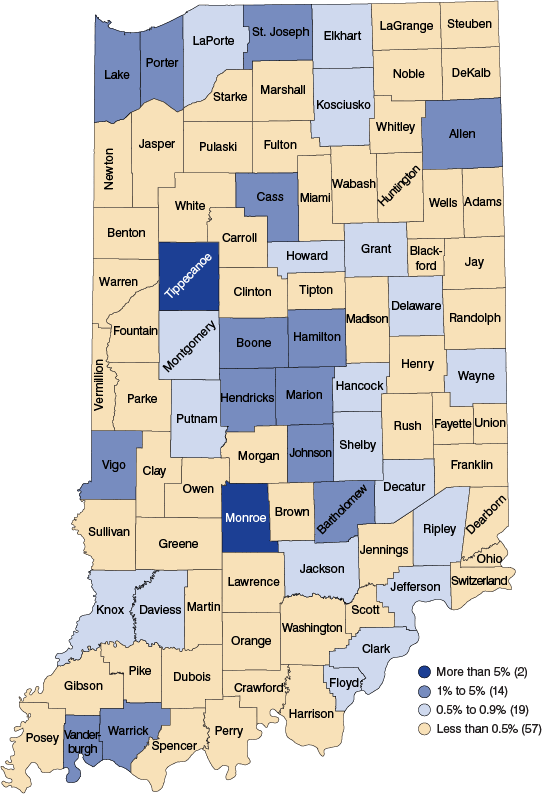
Source: IBRC, using Census 2010 data
All statistics in this article are for the Asian alone population, but it is worth noting that an additional 24,276 Hoosiers report having some Asian ancestry in combination with another race (see Figure 2). While the Asian alone population makes up 1.6 percent of Indiana’s total population, those who specified their race as Asian alone or Asian in combination with another race account for 2 percent of the total population.
Figure 2: Indiana Multiracial Population Reporting Race as Asian in Combination with Another Race, 2010
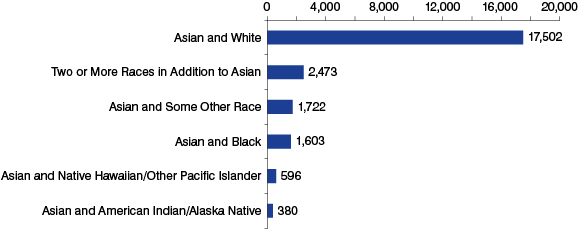
Source: IBRC, using Census 2010 data
Since 2000, Indiana’s Asian population has grown by 73 percent—an increase of 43,348 people. While nine counties saw some decline in their Asian population, 18 counties saw this minority population more than double.
Figure 3 shows that more than a third of the Asian population (36 percent) is between the ages of 25 and 44, with an additional 15 percent in the college age range. The median age for Asians is 30.1 years, compared to 37.1 for the overall population.
Figure 3: Indiana Age Distribution, 2010
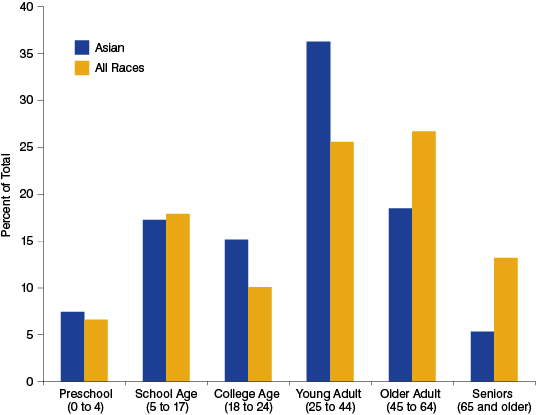
Source: IBRC, using Census 2010 data
Households
Census 2010 reports 18,235 Asian households in the state. (When it comes to race at the household level, the household is characterized based on the race of the primary householder.) The majority of Asian households are comprised of married couples—56 percent compared to 50 percent for the overall population (see Figure 4).
Figure 4: Indiana Households by Type, 2010
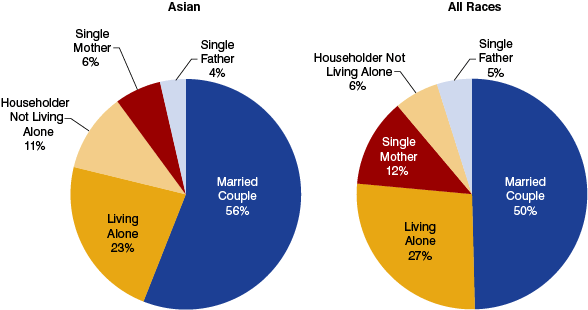
Note: The single-mother category is “female householder, no husband present” and the single-father category is “male householder, no wife present.”
Source: IBRC, using Census 2010 data
42 percent of the Asian population lives in rented units, relative to 28 percent of the total population (see Table 1).
Table 1: Indiana Homeownership, 2010
| Indicator | Asian | All Races |
|---|---|---|
| Owned with a Mortgage or a Loan | 49% | 57% |
| Owned Free and Clear | 9% | 16% |
| Renter Occupied | 42% | 28% |
Note: These percentages are based on the population in occupied housing units.
Source: IBRC, using Census 2010 data
Income and Educational Attainment
Since Census 2010 did not collect any economic data, we must turn to the 2011 American Community Survey (ACS) for this information. Per capita income in 2011 was $24,198 for Indiana’s Asian population, higher than the $23,524 for the overall population. Meanwhile, the median household income for Indiana’s Asian households was $50,648—that’s about $4,200 more than the median for all households in the state ($46,438).
The poverty rate for Asians in Indiana was 19 percent according to the ACS, compared to 16 percent for the overall population.
Figure 5 shows educational attainment for the Asian population broken down by gender. Half of the Asian women living in Indiana and 66 percent of the Asian men have a bachelor’s degree or higher—far surpassing the total population (23 percent) on this measure.
Figure 5: Indiana's Adult Educational Attainment, 2011
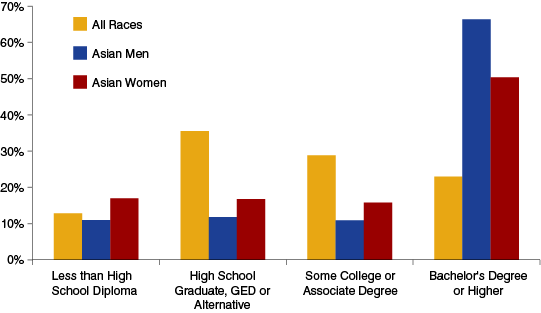
Note: Educational attainment statistics are calculated for those age 25 and older.
Source: IBRC, using American Community Survey data
Learn More
To access more data about Indiana’s Asian population, visit American FactFinder from the U.S. Census Bureau at https://data.census.gov, which contains data from both Census 2010 and the latest American Community Survey.
For a look into Indiana’s other minority groups, visit other articles in this series:
- Indiana’s Black Population
- Indiana’s Hispanic Population
- Indiana’s Native American Population—Coming in the November-December Issue
